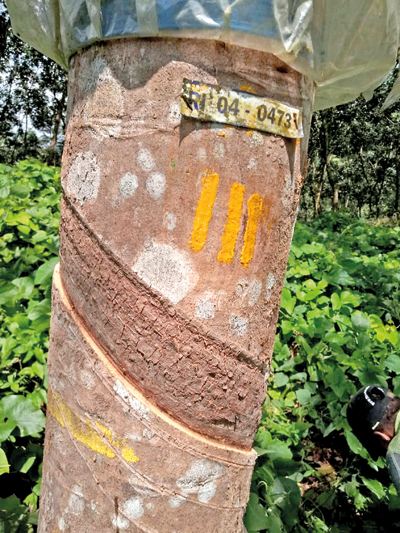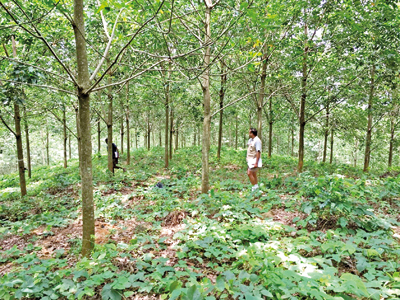Natural rubber cultivations can yet be made profitable
The national rubber yield in Sri Lanka is hovering around 800 to 1,000 kg per hectare per annum over the past five decades. However, this is despite the Rubber Research Institute of Sri Lanka (RRI) introducing to rubber growers good agricultural practices that allow them to achieve an average cycle yield of around 2,000 kg per hectare per annum.

Prof. R.W.M.R.A. Nugawela
Enhancing productivity
Currently recommended rubber clones to the growers have twice as much yield potential relative to what was available to the growers many years ago. Young budded planting material now recommended and made available to the industry has the capacity to give a complete stand of vigorously growing plants in our rubber cultivations and is much superior to bear root budded stumps used by the rubber growers earlier. Undoubtedly, the present day pesticides show much more efficiency in pest and disease control whilst being environmentally friendlier. Tapping is yet continuous excision as done previously, but low frequency tapping systems with the use of stimulants are introduced with the objective of addressing industry issues such as worker shortages, shortening of tapping cycle, lower harvester productivity and high tapping costs. To overcome the loss of crop due to interference of rain on harvesting, the time tested technology of rain guards have been introduced to the growers. Chemical fertiliser to revenue rubber is based on foliar analysis through which growers could provide the precise type and quantity of nutrients to the plantations at a much lower cost. Mentioned above are a few key good agricultural practices the rubber growers could adopt for improved land productivity, profitability and overall performance.
RRI scientists are of the opinion that with the correct adoption of technological advancements listed above, during the peak yielding phase of the tapping cycle a land productivity level of around 3,000 kg per hectare per annum could be achieved against a peak yield of around only 1,500 kg per hectare per annum that was possible earlier. However, the ground reality is that we are yet to see a significant increase in the national yield levels over the past five decades despite the fact that the potential yield has almost doubled during that period. Economic losses to the growers and eventually to the country due to this huge gap between the potential and actual land productivity levels will be colossal. Therefore, one has to find out the exact reasons for this low and stagnating national yield levels enabling to develop strategies to address them.

Tapping Panel Dryness after about only six months of tapping
Possible factors
Simultaneous to the development of novel technologies targeting productivity enhancements in the rubber plantations, the available natural resources and also the business environment in the plantation industry have also changed. The negative impacts due to changes in natural resources and business environment could prevent achieving productivity improvements through technological advancements if appropriate changes are not made to mitigate them.
Though rubber plantations commence with a total stand per hectare of around 520, at the end of the economic life cycle it falls to about 350 – 375. Further, the productive stand contributing to the yield is even lesser than this and it is around 250. The reason for the difference between total and productive stand is the incidence of Tapping Panel Dryness, a physiological disorder resulting in non-yielding trees upon tapping though the trees look healthy. Wind and animal damages and also the incidence of white root disease are the major reasons for the decline in the total stand. A complete healthy stand is a must to achieve potential land productivity. The scenario of the gradual decline in the productive mature stand to about half of what it ideally should be has serious implications on land productivity and profitability. However, it should be emphasised that the phenomenon of Tapping Panel Dryness is yet not well understood even by the scientists and it is on the increase with the introduction of relatively high yielding clones even under good management practices. Hence, the management of the plantations doesn’t have complete control over the resulting loss of land productivity caused by Tapping Panel Dryness.
A rubber tree cannot be tapped to harvest latex if the tapping panel of the tree is wet as it leads to infections in the tapping panel causing the bark of the tree to rot and hence lowering of the tree’s yield potential. Some are of the opinion that tapping of wet panels could also lead to Tapping Panel Dryness. As a result of interference of rain on harvesting, in the traditional rubber growing areas of Sri Lanka we lose around 30 per cent of the potential crop each year. This crop loss is through no tapping, late tapping and washout days. It has become apparent that the recent changes in climatic conditions, i.e. extreme and unpredictable weather conditions, have further increased crop losses due to interference of rain on harvesting.
The fertiliser recommendation based on foliar analysis provides only the essential nutrients to the plants. With this approach the cost of fertiliser is minimised. If this most essential and minimal nutrient requirement is not given to the plantations, reasons such as cash flow issues negative impacts on productivity would be inevitable. The capacity of the soil to retain both nutrients and moisture is also a key factor that governs tree health and its yield. The present rubber cultivations are about the third or the fourth generation. Hence the health of soil in present rubber plantations is much poorer than what it was five decades ago. In the circumstances investment on key agricultural practices like fertiliser application and soil and moisture conservation are vital and has become a fundamental need.
Currently plantations experience a severe shortage of workers. This leads to the inability of adopting recommended agricultural practices on time and also adopting them meeting the desired quality standards. Impact of worker shortage on harvesting is currently very severe. RRI studies reveal that the loss of crop due to lack of harvesters and also by employing unskilled harvesters to meet the requirement is more than 20 per cent.
Similarly, implementation of important agricultural practices connected to replanting is also hampered by worker shortages leading to sub-standard rubber clearings with relatively low yield potentials.
Changes in industry environment
As stated above, there are significant advancements in technology capable of enhancing land productivity. However, the natural resources in rubber lands, climatic conditions and human resources with which we run the industry have also changed over time. Is it these changes that prevent rubber growers achieving a steady growth rate in land productivity? Also, have we developed strategies to mitigate negative impacts caused by changes in business environment in order to manage our rubber plantations in a sustainable manner?

A relatively well managed rubber clearing
It is very much apparent that due to inadequate investments in protecting soil health, repeated planting of the same crop in the same land and extreme weather conditions have now eroded and degraded the soils very much. Continuous planting of same crop with no adequate emphasis on disease management also increases the incidence of common economically important diseases like white root. The plantations now do not enjoy the luxury of systematic weather patterns that prevailed previously. Systematic weather patterns helped in timely adoption of most of the vital agricultural practices such as planting and fertiliser application, which is not the reality now. Further, adequate number of skilled workers to implement cultural practices on a timely basis achieving the required quality standards is also lacking currently. Not having adequate and also skilled harvesters is a major limitation for achieving potential productivity levels. The incidence of tapping panel dryness has increased and is also a concern that needs to be investigated by the scientists. Tapping Panel Dryness should be made one of the major selection criteria when developing and introducing novel clones to the industry. Further, when declaring the yield potential of novel clones to the industry the possible loss of crop due to a clone’s inherent incidence of Tapping Panel Dryness has also to be considered.
Way forward
Among the factors identified above, that prevent achieving of potential productivity, there are certain factors that could be addressed by the management using currently available technologies. The rate of adoption of such technologies is much more important in the present business environment of plantation industry than previously. Hence the management of plantations should be sensitive to the changes in the business environment and the available resources and move forward towards mitigating their negative impacts through improved rate of adoption of relevant technologies.
This is mandatory to make the rubber industry sustainable especially when the trading environment is also poor and uncertain. It is evident that while the business environment in the plantation industry has changed over time, management styles and technologies adopted have not changed adequately. For example in the upstream activities of the industry to get potential yield from high yielding varieties relevant and precise technologies need to be adequately adopted. The continuous decline in land productivity and total natural rubber production in the country will also negatively impact our relatively better performing rubber product manufacturing sector. There is an urgent need to review our present style of managing rubber plantations and make necessary changes so that strategies could be developed and implemented together with adequate monitoring. If a concerted effort is not made to enhance total natural rubber production of the country the natural rubber imports to bridge the gap for product manufacturing sector is inevitable and if it is done without much control could also negatively impact the local rubber prices as well.
Those Plantation Management Companies which were sensitive to change of business environment and adopted adequate measures to mitigate negative impacts are able to achieve a good return on investment even under these challenging environments. The mitigating strategies they have adopted have resulted in a continuous growth in land and worker productivity levels demonstrating the benefits changing management styles rather than to continue to do what was done five decades ago.
(The writer is former Chair, Department of Plantation Management, Wayamba University of Sri Lanka and Director, RRI).


